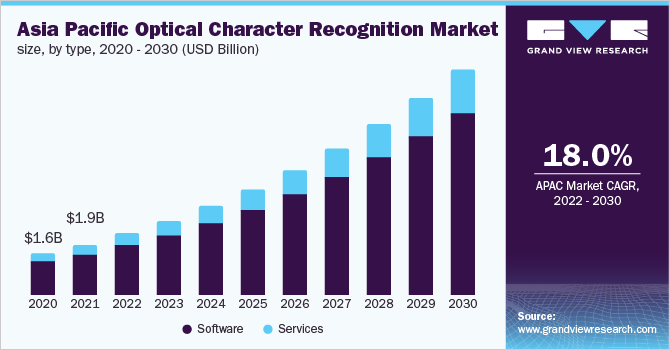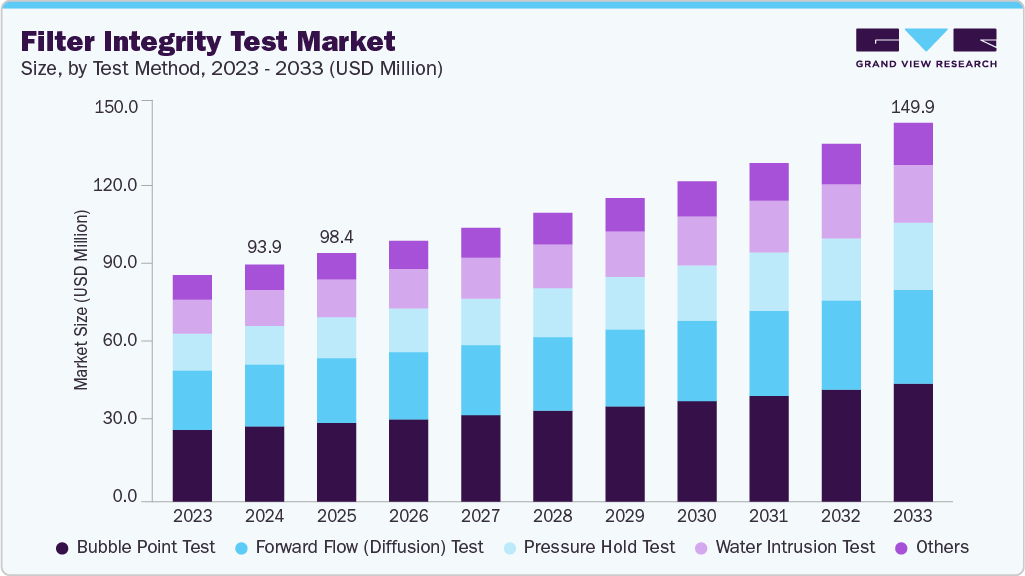Optical Character Recognition Industry Overview
The global optical character recognition market size was valued at USD 8.93 billion in 2021 and is expected to expand at a compound annual growth rate (CAGR) of 15.4% from 2022 to 2030.
The optical character recognition (OCR) technology converts printed and physical documents into machine-readable texts. It extracts scanned papers, image-only pdfs, and camera images and repurposes them. OCR software extracts letters from images and translates them into words and then sentences, allowing access to alter the original text. Moreover, widespread adoption of OCR technology has been observed in BFSI, healthcare, retail, tourism, logistics, transportation, government, manufacturing, and other sectors. The growth of the OCR market is primarily attributed to the improvement in productivity and a rise in the penetration of automatic recognition systems. For instance, in November 2021, HT. KZ, one of the leading travel industries in Kazakhstan, deployed Smart Engine OCR technology that provides document recognition solutions. This technology helps scan its client's passport securely in less than a second through the AI software, which reduces the workload of managers to enter the passport data manually. This solution Combines AI with OCR capabilities.
Gather more insights about the market drivers, restrains and growth of the Global Optical Character Recognition Market
Digitalization in business organizations has made all the processes faster and more accessible. As companies witness technological advancements, data is becoming a critical element for growth. When data is converted to digital form, it can be processed by computers and various devices with computing capacity, and this data is easy to share, access, and store. Companies established before digitalization became a norm in the enterprise sector have also started using tools, such as OCR, to convert their physical data into digital form. The technology also finds increasing application in BFSI and healthcare sectors for creating digital copies of checks, invoices, and other documents. For instance, banks in China utilize OCR software in conjunction with facial recognition software that can protect ATMs as some ATMs require the consumers to input their photo ID, which the program scans for the person’s name and face. They also use OCR software to review the paper applications and other papers that the customer may use to demonstrate responsibility or creditworthiness. Besides, in June 2021, Visionet Systems., a digital solutions provider to the BFSI, launched a new product named DocVu.AI, an AI-powered Intelligent Document Processing. It is a platform for handling a large amount of unstructured and structured data. Banks or financial institutions would easily search, analyze, extract, and manage data sets efficiently. With its AI and machine learning platform, DocVu.AI can meet the needs of the BFSI.

The OCR technology is also being widely used for converting information available in text form into speech with the help of text-to-speech technologies, thus making it accessible to blind and visually impaired individuals. Other applications of the technology include sorting out letters at post offices and documents in law firms and courts, preserving historical and cultural texts, personal identification, and processing invoices, orders, and other documents. For instance, in June 2021, IBM, a U.S.-based company, acquired Turbonomic, an AI-powered application. This acquisition is expected to use AI through machine learning, natural language processing, and optical character recognition.
Numerous benefits of optical character recognition technology have helped companies save time spent on entering data manually in computers, enhancing work management, reducing the cost of converting documents into digital form, and reducing manual errors, among others. It also offers other benefits such as improved customer service and increased documents security, significantly propelling demand across industries, including BFSI and retail. The increased focus of cognitive solution developers on integrating advanced technologies to improve accuracy is also expected to significantly drive the market in the near future. For instance, Envision, a smartphone app that helps blind and low vision users, introduced AI-powered smart glasses helping visually impaired and blind users to have hands-free access and make everyday life more accessible. These smart glasses will have optical character recognition capability.
Browse through Grand View Research's Next Generation Technologies Industry Related Reports
- Machine Learning Market - The global machine learning market size was valued at USD 6.9 billion in 2018 and is anticipated to register a CAGR of 43.8% from 2019 to 2025. Emerging technologies such as artificial intelligence are changing the way industries and humans work.
- Augmented Reality Market - The global augmented reality market size was estimated at USD 25.33 billion in 2021 and is expected to expand at a compound annual growth rate (CAGR) of 40.9% from 2022 to 2030.
Market Share Insights
December 2021: Adobe, a computer software company, partnered with Microsoft, a U.S.-based tech giant. This partnership will help enterprises enable their customer experience with Microsoft Azure, Adobe Experience Cloud, and Microsoft Dynamics.
April 2021: Microsoft acquired Nuance Communications, an AI and speech recognition-based company, and this acquisition would increase the presence of Microsoft cloud for healthcare.
Key Companies profiled:
Some prominent players in the global Optical Character Recognition market include
- ABBYY
- Adobe
- Anyline GmbH
- ATAPY Software
- Captricity Inc.
- Creaceed S.P.R.L.
- CVISION Technologies, Inc.
- Exper-OCR, Inc.
- Google LLC
- International Business Machines Corporation
- IntSig Information Co., Ltd. Corporation
- IRIS S.A.
- LEAD Technologies, Inc.
- Microsoft
- NAVER Corp.
- Nuance Communications, Inc.
- Open Text Corporation
Order a free sample PDF of the Optical Character Recognition Market Intelligence Study, published by Grand View Research.


No comments:
Post a Comment